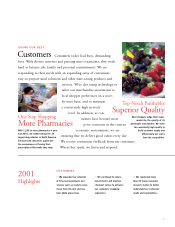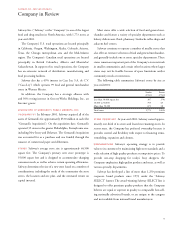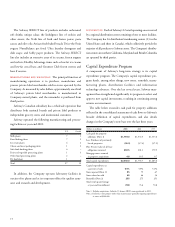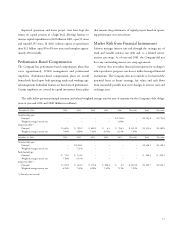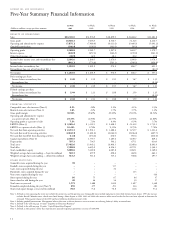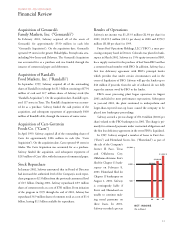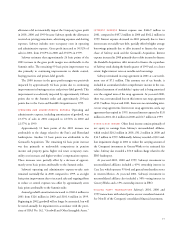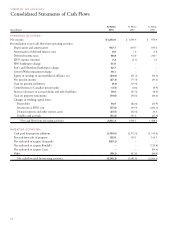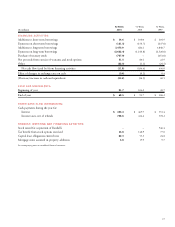Safeway 2001 Annual Report Download - page 16
Download and view the complete annual report
Please find page 16 of the 2001 Safeway annual report below. You can navigate through the pages in the report by either clicking on the pages listed below, or by using the keyword search tool below to find specific information within the annual report.
14
charge to earnings of $42.7 million ($0.05 per share) to recognize
estimated lease liabilities associated with these bankruptcies and for
a single lease from Safeway’s former Florida division.
Safeway has reviewed its potential obligations with respect to
assigned leases relating to other divested operations and, based
on an internal assessment by the Company, Safeway expects that
any potential losses, should there be any similar defaults, would
not be significant to Safeway’s net operating results, cash flow or
financial position.
Safeway also recorded a pre-tax charge of $30.1 million ($0.04
per share) in 2001 to reduce the carrying amount of the
Company’s investment in GroceryWorks Holdings, Inc.
(“GroceryWorks”) to its estimated fair value. In June 2001
GroceryWorks underwent significant changes to its capital struc-
ture and governance including a buyout of the common share-
holders’ interests and an investment of cash and assets by Safeway,
cash by other preferred shareholders and cash and technology by
Tesco PLC, a new third-party strategic investor. The impairment
charge was equal to the difference in Safeway’s recorded invest-
ment in GroceryWorks and Safeway’s share of the estimated fair
value of GroceryWorks based on the valuations indicated by cash
investments in preferred stock in June 2001 (having substantially
the same terms as Safeway’s preferred stock, which is nonre-
deemable, voting and convertible) made by other preferred share-
holders. As a result of these changes, Safeway began accounting
for its investment in GroceryWorks under the equity method
beginning in the third quarter of 2001.
Summit Logistics, a com-
pany that operates Safeway’s
northern California distribu-
tion center, was engaged in a
47-day strike during the
fourth quarter of 2000 (the
“Summit strike”) which had
an adverse effect on sales,
product costs and distribu-
tion expenses at 246 Safeway
stores in northern California,
Nevada and Hawaii. Safeway
is currently in discussions
with Summit over certain of these distribution expenses.
Safeway estimates that the overall cost of the strike, including
all costs under discussion with Summit, reduced 2000 gross
profit by $134 million, reduced operating and administrative
expense by $20 million and reduced pre-tax income by approx-
imately $113.8 million ($0.13 per share). Safeway estimated
the impact of the strike by comparing internal forecasts imme-
diately before the strike with actual results during the strike.
SALES Strong store operations helped increase identical-store
sales (stores operating the entire year in both 2001 and 2000,
excluding replacement stores) 1.6% in 2001, while comparable-
store sales, which include replacement stores, increased 2.3%.
Excluding the estimated effects of the Summit strike on 2000 sales,
identical-store sales increased 1.1% and comparable-store sales
increased 1.8% in 2001.
In 2000, strong store operations helped increase identical-store
sales 2.2% while comparable-store sales increased 2.8%. Excluding
the estimated effects of the Summit strike, which had an unfavor-
able impact on sales in 2000, identical-store sales increased 2.7%
and comparable-store sales increased 3.3% in 2000.
Total sales for the 52 weeks of 2001 were $34.3 billion, com-
pared to $32.0 billion for the 52 weeks of 2000 and $28.9 billion
for the 52 weeks of 1999. 2001 sales increases were attributable
to the Genuardi’s Acquisition, new store openings, increased sales
at continuing stores and the effect of the Summit strike in 2000.
2000 sales increases were attributable to the Randall’s
Acquisition, new store openings and increased sales at continuing
stores, partly offset by the adverse impact of the Summit strike.
GROSS PROFIT Gross profit represents the portion of sales rev-
enue remaining after deducting the costs of inventory sold during
the period, including purchase and distribution costs. In addition,
advertising and promotional expenses, net of vendor allowances,
are a component of cost of goods sold. Vendor allowances that
relate to Safeway’s buying and merchandising activities consist pri-
marily of promotional allowances, advertising allowances and, to
a lesser extent, slotting allowances and are included as a compo-
nent of cost of sales. Vendor allowances totaled $2.3 billion in
2001, $2.1 billion in 2000 and $1.7 billion in 1999. Vendor
PORTIONS OF 2001
SALES DOLLAR
■ Costs of Goods Sold: 69.1%
■ Operating and
Administrating Expense: 23.4%
■ Operatin
g
Profits: 7.5%



